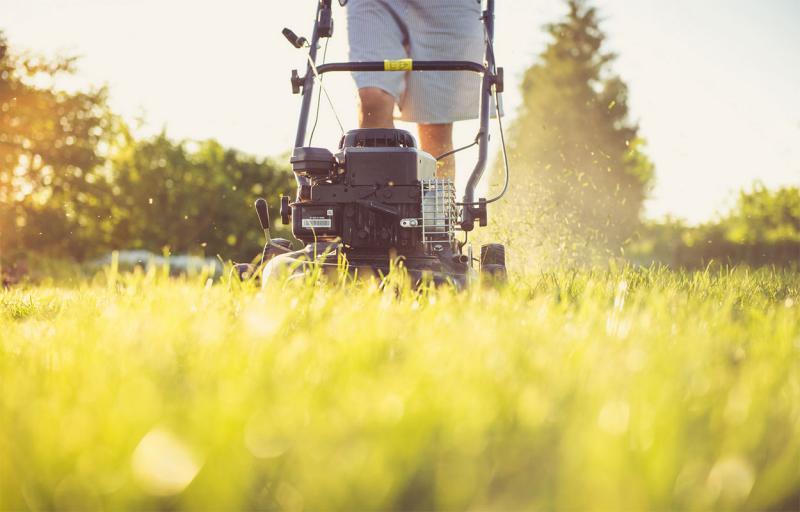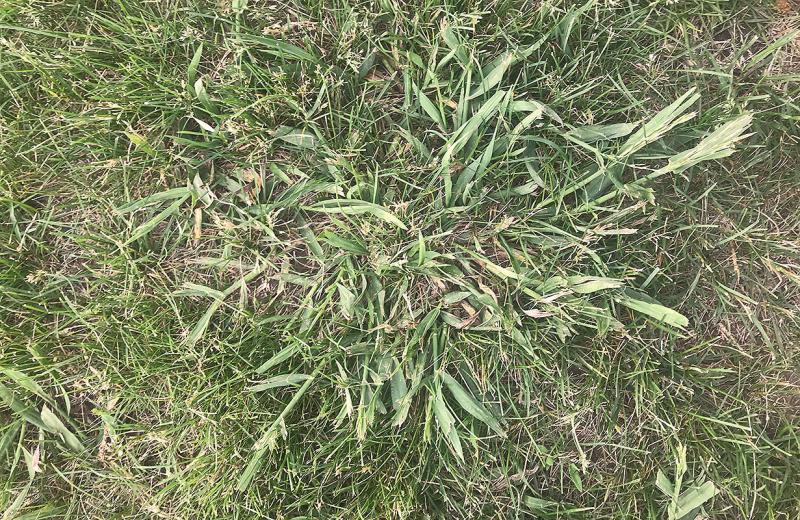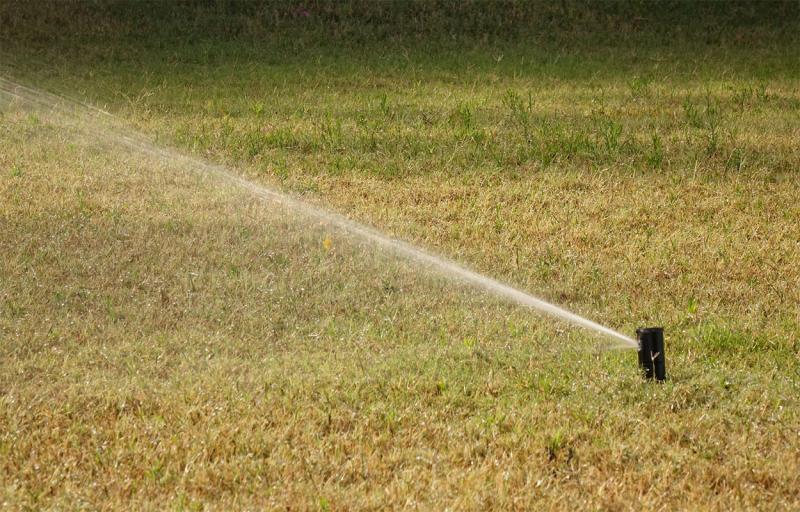Original article by David Chalmers, former South Dakota State University (SDSU) Extension Turfgrass Associate. Updated by Brett Owens, SDSU Instructor of Horticulture and Extension Associate; and Kristine Lang, SDSU Assistant Professor and Extension Specialist in Consumer Horticulture.
During a summer of drought, the extreme heat, lack of rainfall and invasion of pests can really take a toll on our turf. Below are general concepts of summer lawn care and techniques to help your lawn through difficult summer months.
Mowing

- Many of the lawns in South Dakota are made up of Kentucky bluegrass and fescues. These grasses should be mowed to a height of three inches or more. This helps the lawn cope with summer heat stress and shades the soil surface to reduce weed germination. During times of heavy drought and high heat, only mow when absolutely needed. Every mowing of a lawn creates a great deal of stress, especially during hot and dry conditions, and anything we can do to help avoid that stress is beneficial.
- When mowing, do not cut any more than one-third of the total leaf area in any single mowing. If your mower is normally set to a three-inch cutting height, try to mow before the lawn reaches four and one-half inches.
- If your lawn grows more than expected between cuttings, it is always best to adjust the cutting height a notch or two higher, so as not to remove all the accumulated growth in one mowing pass. Phase the mower deck height back to the normal cutting height over two or three cuttings.
- Especially during a dry summer, avoid bagging lawn clippings. Instead use a mulching blade to return grass clippings back into the lawn to help recycle fertilizer nutrients back into the soil where the turf plant can utilize them.
Weed Control

ESTABLISHED LAWNS
Summer, especially during drought and periods of high heat, is a poor time to control perennial broadleaf weeds.
- Weeds need to be actively growing to have the greatest likelihood for good weed control from herbicide applications, summer weed control can often be spotty at best. Weeds in non-irrigated lawns during dry periods are less likely to be controlled by herbicides. Waiting until fall to initiate your weed control program is best. Remember, controlling weeds is a marathon, and you must have a good, long-term plan in place.
- Many broadleaf herbicide product labels state to not apply if daytime temperatures are 85 degrees Fahrenheit or higher to prevent injuring the lawn. During this summer, many of our days easily reach above that temperature.
- Crabgrass usually shows a fair amount of growth and becomes much more noticeable in your lawn in June and subsequent months. During early summer months it may be difficult to control actively growing crabgrass with a single herbicide application. It may take two applications two or three weeks apart to get decent control. Be sure to use a post-emergence crabgrass herbicide to control growing plants, as crabgrass preventers will not kill already growing plants. If crabgrass is becoming an issue in your lawn during the summer, it is best to plan ahead and use a pre-emergence herbicide (also commonly called a crabgrass preventer) next spring.
- Precautionary statements will be spelled out on herbicide product labels. It is the responsibility of the user to read and follow all label directions associated with any herbicide application.
New Turf Establishment
New lawn establishments planted this spring are likely to have new weeds growing along with the new lawn grasses.
- Most herbicide label directions have a recommended waiting period before it is safe to apply herbicides without a risk of injuring the newly planted lawn; however, product label statements can vary greatly in this regard. This waiting period is typically relative to the lawn having made enough growth to have been mowed two, three or more times.
- Mowing the lawn can help keep the weeds in check if summer temperatures make it unsafe to control weeds until fall.
- For minor weed issues, removing weeds by hand or with an appropriate tool is always a great option that does not lead to herbicide damage or stress, especially during hot weather.
Watering

During drought conditions, many communities have watering guidelines for summer water conservation. In many cases, water use is only allowed every other day and is based upon the odd or even home street address. Efficient use of water is good for the community, your lawn and your budget! Be sure to check your local guidelines, as water conservation has become even more important during hot and dry summers.
- Lawn watering practices can be dependent on homeowner preference. Some people prefer to water more frequently to keep the lawn a good, green color, while some will not water and allow their bluegrass lawns to go summer dormant, not watering much at all during extended dry periods.
- When lawns are allowed to go dormant in summer, a light one-quarter to one-half inch watering every three weeks (if not supplied by an occasional rain), will help the growing points (crowns and rhizomes) stay alive to regrow once we reach the cool and moist fall conditions.
- If you do irrigate, the goal is to water deeply and infrequently so that the turfgrass adapts to growing a deeper, more-resilient root system.
- In the absence of rainfall in July and August, applying one to one and a half inches of water per week will maintain good lawn color and growth. This weekly total should not be applied over the course of every single day, but rather occur over two to three deeper waterings in a week. Remember to check your local guidelines for watering restrictions.
- Soils vary greatly in how fast water can infiltrate into the soil. Water only as long as it takes for water to begin to slightly run off the lawn. Many automatic sprinkler settings refer to this practice as “cycle and soak.” All zones are set for realistic, often shorter run times that avoid runoff. Then additional run times are repeated two or three times over the watering period that day to maximize the amount of water that moves into the soil.
- The best time of day to water lawns is early morning, when there is less wind, to improve sprinkler coverage. Additionally, watering early in the morning prevents wasted water that is lost to evaporation during warmer parts of the day. Also, grass blades can dry quickly as the day warms, reducing the possibility of turfgrass disease issues.
Special thanks to SDSU Extension Master Gardeners Tim Schreiner and Stacy Dreis for serving as volunteer copy editors of this article.


